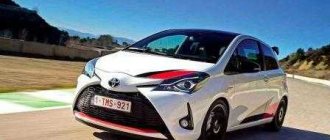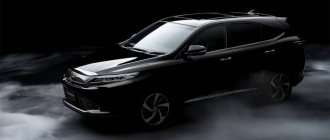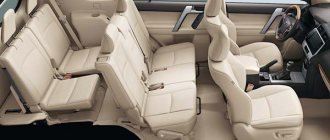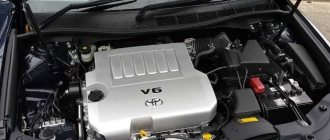The stunning looks of the new 2021 Toyota C-HR combined with crossover functionality should win the heart of any millennial at first sight. I must admit, the car really has charisma.
While Toyota hasn't quite achieved its promised perfect blend of style and comfort, the C-HR is the company's first truly attractive design since the 86. Photo: motor1.com
What is it and what do you eat it with?
Crossover manufacturers are finally starting to think about style, putting a lot of effort into creating distinctive and very attractive cars that no longer look like clunky refrigerators on wheels and boast style and certain design delights. The Toyota C-HR is delightfully sculpted and does not cause a feeling of rejection, even despite its unusual design. It looks like Toyota is finally really moving away from the nonconformism of recent years. When all the world's car brands changed styles several times, Toyota stubbornly adhered to the conservative trend, dictated by concern for the reliability of their cars and almost no desire to satisfy the consumer's increased interest in individuality and unusualness.
C-HR is an abbreviation. It stands for “Coupe High-Rider” or in Russian, “Coupe with a high seating position.” The chosen path of development of the combination of the once incompatible leaves a certain imprint on the car. Both the good and bad elements of a coupe's styling carry over into a crossover. On the positive side, the crossover with a fairly high center of gravity received good handling from the coupe and an overall lean look, but on the other hand, an excess of design solutions does not always have a positive effect on visibility and the driver observes an abundance of “blind spots,” which somewhat upsets users.
See also: 2017 Honda CR-V vs 2021 Toyota RAV4: Which crossover is better
The interior of the car is designed for a decent pastime for 5 people when traveling around the city and a little out of town. The amount of useful space for luggage is unlikely to surprise you with its scope, but it’s quite suitable for trips to Ikea or out of town with children (more on this a little later).
Interior
As for the interior of the new product, at one time they even staged a separate presentation for it, which is understandable: among the brand’s models, the interior of the model turned out to be truly revolutionary.
Professionals from the Calty studio (California) worked on the overall appearance, and European designers from ED2 were involved in the interior design. It was thanks to their efforts that the interior of the crossover received soft lines, a small number of buttons, and the center console in the car is practically absent - it only has an 8” multimedia system screen, to the right of which there is a classic electronic clock. This decision is more of a tribute to fashion, but the designers assure that the screen rising on the front panel does not at all interfere with the view from the driver’s seat.
Among the “highlights” of the compact SUV’s interior is a contrasting strip of black, brown or blue, stretching from one door to door along the front panel, as if encircling the driver and his passenger. The interior captivates both with its design solutions and the quality of the materials used in the decoration: soft plastics are used, and in more expensive versions there is a leather insert on the front panel.
And again to the question of crossovers
No matter how much some car enthusiasts would like to return to the times when full-fledged cars, sedans and station wagons dominated on the road, the number of crossovers in cities is growing exponentially. There are more and more of them in all cities of the world. Look outside, residents of Moscow, St. Petersburg, Novosibirsk or any other city in Russia, and you will certainly see a couple or two of these urban all-terrain vehicles. They are really popular.
Indeed, many who have chosen these cars note a number of their advantages over any other types of passenger cars. This includes spaciousness, a high seating position that allows you to look over the roofs of ordinary cars, and higher ground clearance with increased cross-country ability. Even obvious disadvantages (high center of gravity, less precise handling than cars, increased fuel consumption and higher maintenance costs) cannot overshadow car owners of this type of car.
Crossover mania is sweeping the world and automakers are well aware of this. Therefore, in order to lure new customers and demonstrate the advantages of urban all-terrain vehicles, they are trying to create models that will no longer be inferior in their parameters to conventional passenger cars. SUVs are becoming more beautiful (they have style), they are becoming more productive and powerful, and models of recent years are practically no different in handling from their passenger counterparts. Today we can say with confidence that this class of cars has made a huge leap in its development.
Toyota also keeps up with the general trend and is even ahead of it in some ways, setting its new model as an example. Believe it or not, the C-HR took part in the 24 Hours Nürburgring and the engineers did not hesitate to apply the invaluable experience gained on the track to the production model. Bravo!
With this approach, the crossover is simply bound to get excellent results in road tests and emergency testing.
#6 – Toyota 4Runner
Price: 2,000,000 rubles
After the update, the Toyota 4Runner is practically no different from the previous generation in terms of technical components, but the interior and exterior have changed significantly. In appearance, there are strict and rough lines all over the place, which gives the Toyota 4Runner brutality and masculinity. Everything in the interior meets modern standards - expensive finishing materials and ergonomics. The engine compartment of the car is occupied by a four-liter naturally aspirated gasoline engine, which has as many as 273 horses in its arsenal. It works in tandem with a 5-speed automatic transmission, as well as one of three drive options - front, rear and all-wheel drive.
It's still a Toyota, so it's roomy and comfortable.
The Toyota C-HR is based on a new platform that is shared with some of the larger models in the Japanese automaker's lineup, such as the Toyota Prius. The path of unification is not new and perhaps this is a better path than developing a separate subcompact platform. Toyota did this for a variety of reasons, including better handling and the ability to interchange parts with other Toyotas, but the most noticeable benefit can be seen in the interior space.
Comparing the appearance of the crossover with the internal volume of the cabin, you will simply fall into a stupor; it is simply not comparable to the huge size inside compared to the expectation of cramped space at the first visual acquaintance. The work done on the volume in the front part of the car is especially noticeable, where the wide windows and windshield let in a lot of light. Visibility through the windshield is excellent. The seats are straightforward, strong, average economy class, but they are moderately soft and have a well-thought-out shape to be comfortable during long trips.
Three people can sit in the rear seats, but, as in any compact car, such a close proximity will not provide comfort, but two adults will sit behind the driver and front passenger very comfortably, there is enough space for the legs and the head will not rest against the ceiling, if this is a person of average height. The internal plastic lining of the door does not rest on the side, and the doors are also equipped with thoughtful armrests, which are also designed for long journeys.
The trunk volume behind the 60/40 folding rear seat backs is not large - 377 liters, whatever, frankly small, but as soon as the backs are folded, the volume increases significantly, you can transport large and even long loads. One of the ]Toyota[/anchor] engineers said that in this way they packed 768 cans of Red Bull into the luggage compartment (without the joint advertising of energy drinks) and there was still room for the same amount. This is impressive.
A little more about the second row of seats. You might accept Toyota's decision to ditch the hatch to keep the center of gravity as low as possible, but the rear interior design decision is a claustrophobic dream, even though there's plenty of room inside. The windows at the back are small embrasures through which a little sunlight comes in and after a long stay in the second room you may clearly feel uneasy. The feeling of being in a full-fledged coupe was fully conveyed by Toyota designers. For which we can only congratulate them, in quotes, of course.
In addition to the attacks of fear of limited space in the rear passengers, blind spots are added, which annoy the driver and are the result of an unrestrained flight of design ideas. This dangerous inconvenience is partly solved by the blind spot monitoring system, but you can’t rely on it completely.
verdict on the C- HR's capacity was as follows: "You could carry a whole week's worth of camping gear for two in the back of this thing, complete with bags, tents, sleeping bags, coolers and other small items."
The infotainment system could be more accommodating. A few more words about the internal nuances of the C-HR urban all-terrain vehicle. Let down by an unclear infotainment system, with not the most convenient controls, a somewhat old-fashioned design and the absence of a number of necessary functions. For example, journalists discovered a lack of satellite navigation and satellite radio.
When connecting peripherals, the brains of the entertainment system do not respond immediately, annoying the user with unpleasant delays. You can connect a smartphone to the crossover via Bluetooth or USB to listen to a couple of your favorite tracks. So, you press the play button, and voila!, the audio system starts playing music on the phone through the speakers... of the phone. Only after a couple of seconds, the sound will go into the car stereo. It's a small thing, but unpleasant.
Perhaps with longer use, testing would have shown other nuances of working with the C-HR entertainment audio system, but there was no time for this.
No. 2 – Toyota Land Cruiser 200
Price: 3,000,000 rubles
Toyota Land Cruiser 200, which has long been known to the Russian public, has become even more severe and brutal in 2021. The interior has undergone cosmetic changes - more expensive finishing materials have been added, the architecture of the front panel has been redesigned, and the interior has become much more spacious. For Russian buyers, the Toyota Land Cruiser 200 is offered with a gasoline or diesel engine. The volume of the first is 4.6 liters, power is 309 hp. The second boasts 4.5 liters of volume and 249 horses.
This crossover has proven that it can take corners
The C-HR that you will be able to purchase in the near future, of course, will not be able to set a record for passing the Nurburgring track, even if it is the most powerful version of the crossover*, but you will still get full pleasure from the ride. As we said above, Toyota engineers did not miss the chance to apply racing experience to the production C-HR models. The crossover handles surprisingly well.
See also: Problems in the steering and suspension system
The steering rack is electric and feels as light as you'd expect from a crossover. When driving at low speeds, the force applied to the steering wheel is noticeably reduced for comfortable maneuvering when parking or in city traffic. Nevertheless, those who tested the new product in motion really liked the steering wheel-wheel ; there was no feeling of separation of one element from another. Another plus for ergonomics is the space in the driver's seat. The steering column and instrument panel are designed to provide ample legroom for the driver. They cope with this task perfectly.
The struggle for controllability was carried out on all fronts, including “little things”. For example, Toyota abandoned the idea of installing an optional sunroof in order to keep the center of gravity as low as possible.
The C-HR is a tall car, but not as tall as larger representatives of the SUV family; it is still not a full-fledged SUV; the ground clearance is low. Another sacrifice for better taxiing. The test unit was given a squat feel by a set of TRD springs. Another confirmation that the C-HR is not a truck.
The springs are paired with Sachs shock absorbers. What can you say about them? They perform their part of the duties without complaints, smoothing out road unevenness, without excessive rigidity, they are moderately soft and do not allow the wheels to “thoughtfully” fly up on large uneven surfaces, constantly maintaining the maximum possible contact of the tires with the road.
The similarity with passenger cars also continues in the suspension. At the front, the developer used time-tested MacPherson struts, at the rear there are double wishbones and a 26 mm anti-roll bar. Of course, disc brakes are installed all around, offering stable deceleration with adequate feedback.
And again we return to the fact that this is a crossover. Yes, the team did a lot of work during the design, but the main two disadvantages could not be completely avoided.
- 1. The car is tall, and its center of gravity is higher than that of passenger cars.
- 2. The curb weight of the car is quite large - from 1,320 to 1,497 kg. This small car can hardly be called light.
And one more important detail, the car is configured to understeer, take this into account during operation.
During a test drive, journalists from the States, not yet fully accustomed to driving an all-terrain vehicle, found themselves in an unpleasant situation. The path ran through winding roads in the suburbs of Austin, Texas. And when entering one of the closed turns, the driver, carried away, did not calculate the speed, exceeding it slightly. The demolition of the front axle began... The unpleasant syndrome was stopped in the bud using the trail breaking technique, gentle braking at the entrance to the turn, which loads the front axle and increases the grip of the front wheels with the road surface. The car stabilized its trajectory and was successfully avoided from drifting into the oncoming lane.
We, at 1GAI.RU, are for safe driving, so we illustrated with this example one of the most dangerous violations on the road - speeding and its consequences. We strongly DO NOT recommend using this racing equipment on public roads! And of course, do not exceed the speed limit.
*In Russia, according to the website quto.ru, the first generation Toyota C-HR will be sold in basic configurations with the simplest engines: 1.2 (116 hp), 1.8 (122 hp) and 2.0 (148 hp) . Therefore, you won’t have to expect any dynamics from such versions at all. All of them will accelerate the 1.3-ton crossover to 100 km/h in about 11 seconds.
#7 – Toyota Venza
Price: 2,200,000 rubles
The Toyota Venza receives bronze in the rating. This is a representative of the mid-size crossover category. The model borrows the best qualities of cars of other form factors - the practicality of a station wagon, the cross-country ability of crossovers and the handling of a sedan. The target audience of the model is families with several children. In appearance, a combination of several styles is also visible, with all this the car looks interesting and even original. The interior does not have any sophisticated elements, but nevertheless it looks elegant and very expensive. The front panel is ergonomic and made in accordance with generally accepted standards; all the necessary mechanisms are located in places convenient for the driver. The finishing materials, although simple, are reliable and of high quality, and the interior space of the cabin will allow all passengers, without exception, to travel comfortably.
The Venza is supplied to the domestic market only with a gasoline engine, the volume of which is 2.7 liters. Its power is 185 hp. It is paired with a 6-speed automatic transmission and front-wheel drive as standard. If you need the all-wheel drive option, you can always pay extra and get an electromechanical clutch. Toyota Venza conquers the “duty hundred” in 9.4 seconds, and the speed limit is 180 km/h.
He wants to keep you out of trouble
Toyota Safety Sense P is a proprietary collision avoidance system that comes complete with pedestrian detection, lane departure warning, adaptive cruise control (automatically slows down the car if you miss a dangerous moment) and automatic high beams.
During testing, it was noted that the lane departure warning system behaved a little nervously on two-lane roads.
A standard stabilization and traction control system, an anti-lock braking system and 10 airbags will keep you and your passengers safe.
#4 - Toyota Sequoia
Price: 6,330,000 rubles
Toyota Sequoia, which was already easily identified, has become even more recognizable thanks to its strict and business-like appearance. The interior has been redesigned and now the owner of Toyota Sequoia has at his disposal an ergonomic interior with an increased level of safety. Under the hood of the car is a V8 engine with a volume of 5.7 liters and a power of 386 horses. Thanks to him, Toyota Sequoia confidently stays on the road and overcomes any obstacles that it encounters on its way. All this is accompanied by comfort and the highest smoothness of control.
The engine in the C-HR will hum vigorously, but the CVT will not provide dynamics
CVT (variable transmission) Toyota. In a nutshell, the transmission is simply terrible! The CVT was programmed to disguise the operation as a conventional automatic transmission, but this did not help it. By all parameters, you can easily determine that it is a CVT in front of you, and you will be convinced of this from the worst side of this issue. His work is slow, viscous like jelly and he is constantly dumb. For the stupidity, special thanks to the attempt to disguise itself as an automatic transmission, which causes the variator to constantly get confused in the feeling of “sportiness”, randomly drop and raise the speed without rational and visible reasons, confusing the driver and annoying with its unpredictability.
According to journalists, even the slowest CVT transmission in terms of shift speed will be much better than an unpredictable pretender. The destiny of a CVT transmission is to work smoothly and not irritate, at least with its “stupidity”. And the relative slowness of switching can be forgiven for a family SUV.
Toyota claims its turbocharged 2.0-liter four-cylinder engine produces just 148 horsepower at 6,100 rpm and 189 pound-feet of torque at 3,800 rpm. In this case, the turbine solves, or rather tries to solve, the problem of modest power.
Note that there is a lack of power effect at low revs. The engine must spin up a little to reach acceptable torque levels. Then a certain pick-up will appear and the one and a half ton car will more actively mingle with its light-alloy round legs.
The result is that the car, despite its somewhat sporting roots, is not for racers.
No. 3 – Toyota Land Cruiser Prado
Price: 2,300,000 rubles
Toyota Land Cruiser Prado is one of the most popular Toyota products among Russian car enthusiasts, so its presence in our rating is quite justified. Brutal design and excellent driving performance combined with reliability - that’s why this model is so popular among our compatriots.
Under the hood of the Toyota Land Cruiser Prado you can find one of several power units. The first option is a 2.7-liter gasoline engine with a power of 163 hp, which works in tandem with a 5-speed manual transmission. The flagship version is equipped with a V6 engine with 249 horsepower.
Early verdict
So, what was the preliminary verdict given by journalists who tested the crossover in road conditions? The C-HR is perhaps the most beautiful and unusual-looking crossover in its segment. The Toyota car looks fresh and even futuristic to some extent. Five points for this. The interior is generally good, roomy and well thought out, but not without its shortcomings. However, in this segment this can be forgiven.
The only inconsistency raises a question. A city SUV with such good handling should be fast and powerful. Where is the power and speed? Why does a car lull you to sleep with its dynamics and the variator shows “jelly” performance? Have Toyota engineers prepared a surprise and will make top-end powerful options? Let's hope that this is the plan.
In the meantime, a solid four. But you must admit, this guy has the makings!
#8 – Toyota Fortuner
Price: 2,000,000 rubles
Externally, the Toyota Fortuner gives the impression of a stern and businesslike car; such a solution will certainly be appreciated by businessmen and other car enthusiasts representing the stronger half of our planet. Throughout the cabin you can see expensive decorative wood-look inserts, high-quality finishing materials, including genuine leather and expensive plastic, as well as a huge amount of free space between the rows, which will give passengers extremely positive emotions during a trip to the Toyota Fortuner.
The technical component of the car is represented by a gasoline unit with a volume of 2.7 liters and a power of 166 hp; its competitor is a turbo diesel with a volume of 2.8 liters and 177 hp. In the top configuration, the Toyota Fortuner accelerates to hundreds in 11.2 seconds, and its petrol competitor in 12 seconds.











